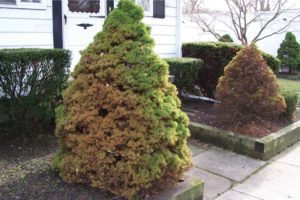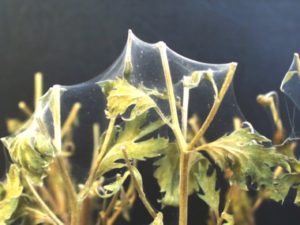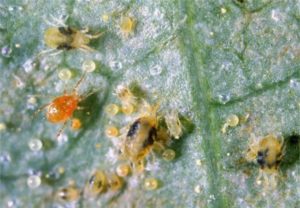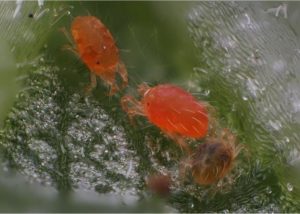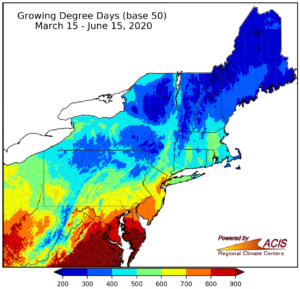Sweet Corn
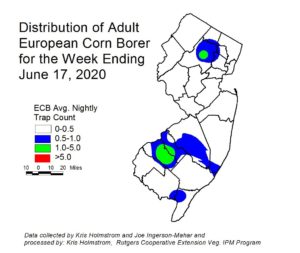 European corn borer (ECB) moth catches increased somewhat over the past week although higher numbers were recorded in a relatively low number of locations. At this time, activity is highest in Gloucester and central Morris counties (see ECB map at left). Catches remain widely dispersed. Larval infestations into the 30+% range were detected as far north as Morris County this past week. As moth catches begin to fall, larval development and damage increase. We expect that these infestation rates will continue to climb for the next 1-2 weeks in many parts of the state.
European corn borer (ECB) moth catches increased somewhat over the past week although higher numbers were recorded in a relatively low number of locations. At this time, activity is highest in Gloucester and central Morris counties (see ECB map at left). Catches remain widely dispersed. Larval infestations into the 30+% range were detected as far north as Morris County this past week. As moth catches begin to fall, larval development and damage increase. We expect that these infestation rates will continue to climb for the next 1-2 weeks in many parts of the state.
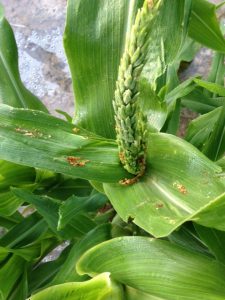 Look for the characteristic “shot-hole” type of feeding (photo below at right) and consider treating when infested plants exceed 12% in a 50 plant sample. As plantings proceed to the pre-tassel stage, ECB larvae may be found in emerging tassels (see photo at left). It is a good idea to treat individual plantings as they move into the full tassel/first silk stage one time. This eliminates any ECB larvae that have emerged with the tassels as they begin to move down the stalk to re-enter near developing ears.
Look for the characteristic “shot-hole” type of feeding (photo below at right) and consider treating when infested plants exceed 12% in a 50 plant sample. As plantings proceed to the pre-tassel stage, ECB larvae may be found in emerging tassels (see photo at left). It is a good idea to treat individual plantings as they move into the full tassel/first silk stage one time. This eliminates any ECB larvae that have emerged with the tassels as they begin to move down the stalk to re-enter near developing ears.
Useful insecticides for this particular application include synthetic 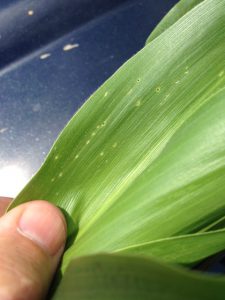 pyrethroids (IRAC Grp 3), spinosyns (including OMRI approved Entrust) IRAC Grp 5), and diamides such as Coragen (IRAC Grp 28) or materials such as Besiege which include the active ingredient in Coragen. Synthetic pyrethroids alone should NOT be used for corn earworm (CEW) protection on silking corn. Control with these materials is very inconsistent.
pyrethroids (IRAC Grp 3), spinosyns (including OMRI approved Entrust) IRAC Grp 5), and diamides such as Coragen (IRAC Grp 28) or materials such as Besiege which include the active ingredient in Coragen. Synthetic pyrethroids alone should NOT be used for corn earworm (CEW) protection on silking corn. Control with these materials is very inconsistent.
The highest nightly trap catches of ECB for the week ending 6/17/20 are as follows:
| Eldora 2 | Crosswicks 1 | Medford 1 |
| Allentown 1 | Denville 1 | New Egypt 1 |
| Blairstown 1 | Downer 1 | Springdale 1 |
| Cinnaminson 1 | Elm 1 | Tabernacle 1 |
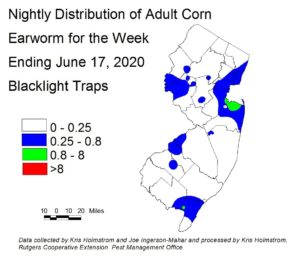 Increased catches of corn earworm (CEW) moths were recorded this past week. As early plantings proceed to full tassel and on to silk, they will need protection from this pest. Blacklight catches (see map at left) were scattered, but higher in locations than the previous week.
Increased catches of corn earworm (CEW) moths were recorded this past week. As early plantings proceed to full tassel and on to silk, they will need protection from this pest. Blacklight catches (see map at left) were scattered, but higher in locations than the previous week.
The highest nightly trap catches of CEW in black light traps for the week ending 6/17/20 are as follows:
| Matawan 3 | Clinton 1 | Hackettstown 1 |
| Asbury 1 | Downer 1 | Hillsborough 1 |
| Bellemeade 1 | Eldora 1 | New Egypt 1 |
| Cinnaminson 1 | Green Creek 1 | Springdale 1 |
